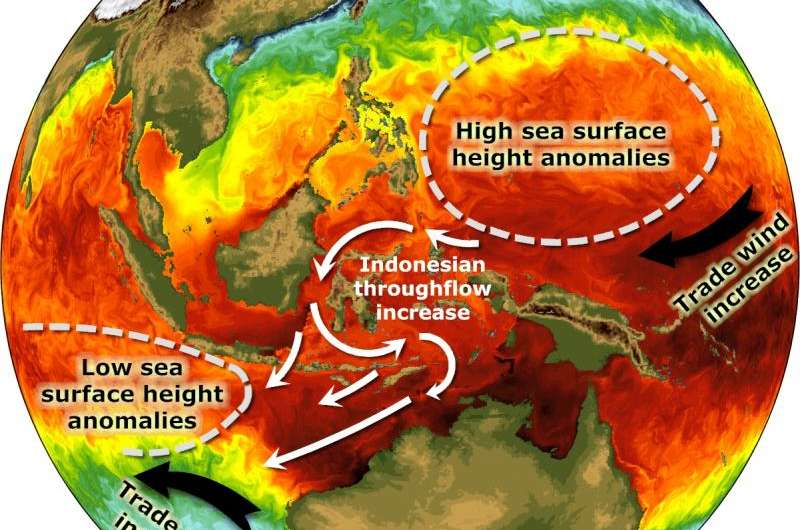May 19, 2015 report
Heat from global warming captured by the Pacific Ocean being transferred to Indian Ocean

(Phys.org)—A team of researchers working in the U.S. has found what they believe to be the answer to the question of what happened to the heat uptake in the Pacific Ocean due to global warming. In their paper published in Nature Geoscience, they suggest that it has been transferred to the Indian Ocean. Jérôme Vialard with Université Sorbonne offers a News & Views piece on the work done by the team in the same journal issue.
Most scientists now agree that planet Earth is experiencing global warming, and has been for several decades—most also agree that the cause is an influx of carbon dioxide from human activities. But recent reports that global surface temperatures stopped rising over the past ten to fifteen years, has caused some to become skeptical of the whole idea, even as many scientists have suggested that the surface temperature plateau has been caused by the worlds' oceans serving as a giant heat sink. The problem with that argument though, has been lack of data suggesting that the biggest of our oceans, the Pacific, has seen a temperature increase. In this new effort, the researchers believe they have found out why.
In studying ocean temperature data provided by NOAA covering the past several decades, the researchers found that surface temperatures for the Pacific actually decreased over the past ten years. Recognizing that the heat had to go somewhere, the researchers input the data into models that have been built to show global temperatures, wind movement and other meteorological data. The model showed heat building up in the western Pacific and then being carried by easterly trade winds through the Indonesian archipelago. Upon closer inspection, the team found that surface temperatures (down to 700 meters) in the Indian Ocean had in fact increased to the point that it could account for approximately 70 percent of the heat taken up by the atmosphere over the past decade.
The finding by the team appears to be both good and bad news. The good news is that it adds credence to global warming theories—the bad news is that it means that it is possible that at some point in the future all that heat in the ocean could be released back into the atmosphere, creating a sudden temperature spike which would almost assuredly cause massive worldwide problems for those of us that caused the problem in the first place.
More information: Pacific origin of the abrupt increase in Indian Ocean heat content during the warming hiatus, Nature Geoscience (2015) DOI: 10.1038/ngeo2438
Abstract
Global mean surface warming has stalled since the end of the twentieth century, but the net radiation imbalance at the top of the atmosphere continues to suggest an increasingly warming planet. This apparent contradiction has been reconciled by an anomalous heat flux into the ocean, induced by a shift towards a La Niña-like state with cold sea surface temperatures in the eastern tropical Pacific over the past decade or so. A significant portion of the heat missing from the atmosphere is therefore expected to be stored in the Pacific Ocean. However, in situ hydrographic records indicate that Pacific Ocean heat content has been decreasing9. Here, we analyse observations along with simulations from a global ocean–sea ice model to track the pathway of heat. We find that the enhanced heat uptake by the Pacific Ocean has been compensated by an increased heat transport from the Pacific Ocean to the Indian Ocean, carried by the Indonesian throughflow. As a result, Indian Ocean heat content has increased abruptly, which accounts for more than 70% of the global ocean heat gain in the upper 700 m during the past decade. We conclude that the Indian Ocean has become increasingly important in modulating global climate variability.
Journal information: Nature Geoscience
© 2015 Phys.org


















